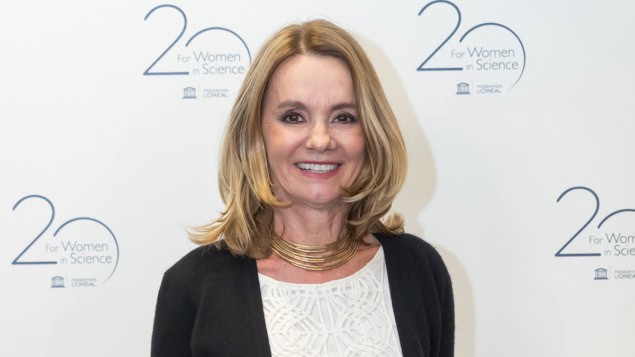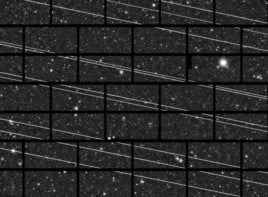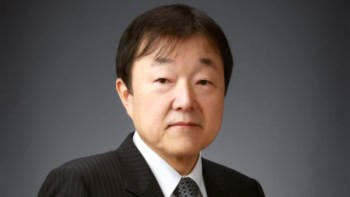Thaisa Storchi Bergmann, who won the L’Oréal-UNESCO For Women in Science prize in 2015, talks to Meghie Rodrigues about extragalactic astronomy, doing high-impact international research, and being a woman in South American physics

As a teenager in her native Rio Grande do Sul, a state in Southern Brazil, Thaisa Storchi Bergmann enjoyed experimenting in an improvised laboratory her parents built in their attic. They didn’t come from a science background – her father was an accountant, her mother a primary school teacher – but they encouraged her to do what she enjoyed. With a friend from school, Storchi Bergmann spent hours looking at insects with a microscope and running experiments from a chemistry toy kit. “We christened the lab Thasi-Cruz after a combination of our names,” she chuckles.
At the time, Storchi Bergmann could not have imagined that one day this path would lead to cosmic discoveries and international recognition at the frontiers of astrophysics. “I always had the curiosity inside me,” she recalls. “It was something I carried since adolescence.”
That curiosity almost got lost to another discipline. By the time Storchi Bergmann was about to enter university, she was swayed by a cousin living with her family who was passionate about architecture. By 1974 she began studying architecture at the Federal University of Rio Grande do Sul (UFRGS). “But I didn’t really like technical drawing. My favourite part of the course were physics classes,” she says. Within a semester, she switched to physics.
There she met Edemundo da Rocha Vieira, the first astrophysicist UFRGS ever hired – who later went on to structure the university’s astronomy department. He nurtured Storchi Bergmann’s growing fascination with the universe and introduced her to research.
In 1977, newly married after graduation, Storchi Bergmann followed her husband to Rio de Janeiro, where she did a master’s degree and worked with William Kunkel, an American astronomer who was in Rio to help establish Brazil’s National Astrophysics Laboratory. She began working on data from a photometric system to measure star radiation. “But Kunkel said galaxies were a lot more interesting to study, and that stuck in my head,” she says.
Three years after moving to Rio, she returned to Porto Alegre, in Rio Grande do Sul, to start her doctoral research and teach at UFRGS. Vital to her career was her decision to join the group of Miriani Pastoriza, one of the pioneers of extragalactic astrophysics in Latin America. “She came from Argentina, where [in the late 1970s and early 1980s] scientists were being strongly persecuted [by the country’s military dictatorship] at the time,” she recalls. Pastoriza studied galaxies with “peculiar nuclei” – objects later known to harbour supermassive black holes. Under Pastoriza’s guidance, she moved from stars to galaxies, laying the foundation for her career.
Between 1986 and 1987, Storchi Bergmann often travelled to Chile to make observations and gather data for her PhD, using some of the largest telescopes available at the time. Then came a transformative period – a postdoc fellowship in Maryland, US, just as the Hubble Space Telescope was launched in 1990. “Each Thursday, I would drive to Baltimore for informal bag-lunch talks at the Space Telescope Science Institute, absorbing new results on active galactic nuclei (AGN) and supermassive black holes,” Storchi Bergmann recalls.
Discoveries and insights
In 1991, during an observing campaign, she and a collaborator saw something extraordinary in the galaxy NGC 1097: gas moving at immense speeds, captured by the galaxy’s central black hole. The work, published in 1993, became one of the earliest documented cases of what are now called “tidal disruption events”, in which a star or cloud gets too close to a black hole and is torn apart.
Her research also contributed to one of the defining insights of the Hubble era: that every massive galaxy hosts a central black hole. “At first, we didn’t know if they were rare,” she explains. “But gradually it became clear: these objects are fundamental to galaxy evolution.”
Another collaboration brought her into contact with Daniela Calzetti, whose work on the effects of interstellar dust led to the formulation of the widely used “Calzetti law”. These and other contributions placed Storchi Bergmann among the most cited scientists worldwide, recognition of which came in 2015 when she received the L’Oréal-UNESCO Award for Women in Science.
Her scientific achievements, however, unfolded against personal and structural obstacles. As a young mother, she often brought her baby to observatories and conferences so she could breastfeed. This kind of juggling is no stranger to many women in science.
“It was never easy,” Storchi Bergmann reflects. “I was always running, trying to do 20 things at once.” The lack of childcare infrastructure in universities compounded the challenge. She recalls colleagues who succeeded by giving up on family life altogether. “That is not sustainable,” she insists. “Science needs all perspectives – male, female and everything in-between. Otherwise, we lose richness in our vision of the universe.”
When she attended conferences early in her career, she was often the only woman in the room. Today, she says, the situation has greatly improved, even if true equality remains distant.
Now a tenured professor at UFRGS and a member of the Brazilian Academy of Sciences, Storchi Bergmann continues to push at the cosmic frontier. Her current focus is the Legacy Survey of Space and Time (LSST), about to begin at the Vera Rubin Observatory in Chile.
Her group is part of the AGN science collaboration, developing methods to analyse the characteristic flickering of accreting black holes. With students, she is experimenting with automated pipelines and artificial intelligence to make sense of and manage the massive amounts of data.
Challenges ahead
Yet this frontier science is not guaranteed. Storchi Bergmann is frustrated by the recent collapse in research scholarships. Historically, her postgraduate programme enjoyed a strong balance of grants from both of Brazil’s federal research funding agencies, CNPq (from the Ministry of Science) and CAPES (from the Ministry of Education). But cuts at CNPq, she says, have left students without support, and CAPES has not filled the gap.
“The result is heartbreaking,” she says. “I have brilliant students ready to start, including one from Piauí (a state in north-eastern Brazil), but without a grant, they simply cannot continue. Others are forced to work elsewhere to support themselves, leaving no time for research.”
She is especially critical of the policy of redistributing scarce funds away from top-rated programmes to newer ones without expanding the overall budget. “You cannot build excellence by dismantling what already exists,” she argues.
For her, the consequences go beyond personal frustration. They risk undermining decades of investment that placed Brazil on the international astrophysics map. Despite these challenges, Storchi Bergmann remains driven and continues to mentor master’s and PhD students, determined to prepare them for the LSST era.
At the heart of her research is a question as grand as any in cosmology: which came first – the galaxy or its central black hole? The answer, she believes, will reshape our understanding of how the universe came to be. And it will carry with it the fingerprint of her work: the persistence of a Brazilian scientist who followed her curiosity from a home-made lab to the centres of galaxies, overcoming obstacles along the way.



